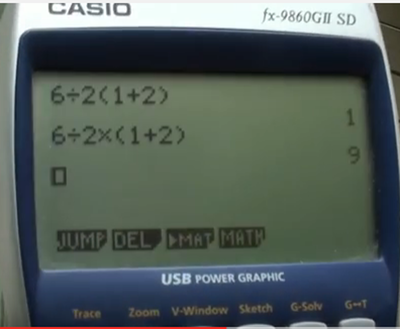The equation that broke the Internet
6÷2(1+2)=? is the pre-algebra question that a majority of respondents seem to get wrong. If you are in the camp that knows the correct answer is 1, read no further. If you believe the answer is 9, you should probably review this document -- there is only one number that 6 can be divided by to result in 9, and that number is 2/3.
Contents
Proof incorrect solution
We substitute x for 2(1+2) from the given equation:
If
- 6÷x = 9
then
- 6÷9 = x
there is a Common Denominator of 3 so we reduce the fraction...
- 2÷3 = x
Now we compare the value given in the equation to the value we find for x.
- 2÷3 != 2(1+2)
Therefore:
- 6÷2(1+2) != 9
Processing rules
In the majority of incorrect proofs, the respondent will cite PEMDAS or BODMAS, however these solvers incorrectly resolve the [P]arentheses or [B]rackets of PEMDAS - BODMAS, ignoring the Distributive Law. For some reason, they believe that they can solve within the parentheses, but ignore the adjacent and dependent coefficient.
Wolfram Mathworld on parenthetical expressions:
- 1. Parentheses are used in mathematical expressions to denote modifications to normal order of operations (precedence rules)...
- [...]
- 3. Parentheses are used to enclose the variables of a function in the form f(x), which means that values of the function f are dependent upon the values of x.
- –Parenthesis
Encyclopedia Britticana on parenthetical expressions:
- Distributive law, in mathematics, the law relating the operations of multiplication and addition, stated symbolically, a(b + c) = ab + ac; that is, the monomial factor a is distributed, or separately applied, to each term of the binomial factor b + c, resulting in the product ab + ac.
- –Encyclopedia Britticana
Therefore, in 6÷2(1+2)=?, we start with the Distributive Law in the Parenthesis step of the Order of Operations.
- 6÷2(1+2)=?
- 6÷(2*1 + 2*2)=?
- 6÷(2 + 4)=?
- 6÷(6)=?
- 6÷6=1
So the fatal error with solvers who emphasize the left to right rule, is in incorrectly handling the Parentheses step, disregarding the Distributive Law.
- 6÷2(3)
Some are even compelled to add an explicit multiplier, not given in the equation.
- 6÷2*(3)
The Fundamentals of Algebra (1983)
Parenthetical Expression. The parenthesis was described in Chapter 1 as a grouping symbol. When an algebraic expression is enclosed by a parenthesis it is known as a parenthetical expression. When a parenthetical expression is immediately preceded by coefficient, the parenthetical expression is a factor and must be multiplied by the coefficient. This is done in the following manner.
- 5(a + b) = 5a + 5b
- 3a(b - c) = 3ab - 3ac
–"Technical Shop Mathematics / Edition 2", by John G. Anderson, ISBN-13:9780831111458, Industrial Press, Inc., 02/28/1983, Page:138
The equation is not ambiguous
6÷2(1+2) is not equal to 6÷2*(1+2)
Standing alone, 6 will always equal 6 and 2(1+2) will also always equal 6, so dividing these two terms will always equal 1. We would not write 2(a+b) as (2(a+b)), nor would we re-write the given equation as 6÷2*(a+b). Granted, the obelus (÷) is an archaic symbol for division, but this is not a postgraduate level equation, this is middle-school level math.
2(1+2) is understood to be a function, placing this function anywhere in a larger equation must always resolve to the same value. The equation, 6÷2(1+2)=? is illustrative to why we cannot substitute explicit multiplication for implied multiplication, in other words, 6÷2(1+2) is not equal to 6÷2*(1+2).
Implied multiplication has a higher priority than explicit multiplication to allow users to enter expressions, in the same manner as they would be written.
–Implied Multiplication Versus Explicit Multiplication on TI Graphing Calculators
Correctly solving left to right
If we insist on a left to right solution, ignoring both PEMDAS and the Distributive Law, we can do this with the Least Common Denominator rule
- 6÷2(1+2)=?
- 3÷(1+2)=?
- 3÷(3)=?
- 3÷3=1
When we reduce by the common denominator, the division is sustained...
Solution written as a fraction
In the denominator, both the coefficient and the factor must be divided in the following manner.
6
2(1+2)
=
3
(1+2)
=
3
3
= 1
The calculator problem
The Desmos Scientific Calculator handles our given equation correctly. The error checking appears to be built into the division key.
Entering the equation into a programming language, or low quality calculator requires the explicit multiplication symbol and outer parenthesis.
6÷2(1+2) == 6÷(2*(1+2))
Entering the equation as 6/2(1+2) into a cell in a LibreOffice Calc spreadsheet will result in Err:509 (Missing operator) This forces the user to format the equation using explicit multiplication. To avoid the left to right problem in programming languages, the compiler must be instructed in advance to prepare for the function with an extra pair of parenthesis 6/(2*(1+2)).
